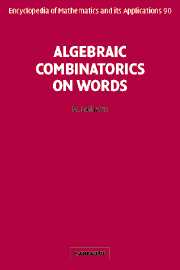Book contents
- Frontmatter
- Contents
- Preface
- Chapter 1 Finite and Infinite Words
- Chapter 2 Sturmian Words
- Chapter 3 Unavoidable Patterns
- Chapter 4 Sesquipowers
- Chapter 5 The Plactic Monoid
- Chapter 6 Codes
- Chapter 7 Numeration Systems
- Chapter 8 Periodicity
- Chapter 9 Centralizers of Noncommutative Series and Polynomials
- Chapter 10 Transformations on Words and q-Calculus
- Chapter 11 Statistics on Permutations and Words
- Chapter 12 Makanin's Algorithm
- Chapter 13 Independent Systems of Equations
- References
- Index of Notation
- General Index
Chapter 11 - Statistics on Permutations and Words
Published online by Cambridge University Press: 05 April 2013
- Frontmatter
- Contents
- Preface
- Chapter 1 Finite and Infinite Words
- Chapter 2 Sturmian Words
- Chapter 3 Unavoidable Patterns
- Chapter 4 Sesquipowers
- Chapter 5 The Plactic Monoid
- Chapter 6 Codes
- Chapter 7 Numeration Systems
- Chapter 8 Periodicity
- Chapter 9 Centralizers of Noncommutative Series and Polynomials
- Chapter 10 Transformations on Words and q-Calculus
- Chapter 11 Statistics on Permutations and Words
- Chapter 12 Makanin's Algorithm
- Chapter 13 Independent Systems of Equations
- References
- Index of Notation
- General Index
Summary
Introduction
This chapter is devoted, as was the previous one, to combinatorial properties of permutations, considered as words. The starting point in this subject is the bivalent status of permutations, which can be considered as products of cycles as well as a sequence of the first n integers written in disorder.
The fundamental results concerning this area are presented in Chapter 10 of Lothaire 1983. They consist essentially in two transformations on words. The first one (first fundamental transformation) is an encoding of the cycle decomposition of a permutation. The second one (second fundamental transformation) accounts for a statistical property of permutations, namely the equidistribution of the number of inversions and the inverse major index on permutations with a given shape.
In the previous chapter (Chapter 10) some other properties are presented, including basic facts on q-calculus and additional statistics on permutations.
In this chapter, we carry on with complements focused on two main aspects. The first one is a shortcut avoiding the second fundamental transformation by a simple evaluation of determinants. The second one is the analogy between the first fundamental transformation and the Lyndon factorization (the Gessel normalization).
The organization of the chapter is the following. After some preliminaries, Section 11.2 provides a determinantal expression for the commutative image of some sets of words. This expression is used in Sections 11.3 and 11.4, for evaluating respectively the inverse major index and the number of inversions of permutations with a given shape. In Section 11.5 the Gessel normalization is introduced. In Section 11.6, it is then applied to evaluating the major index of permutations with a given cycle structure.
- Type
- Chapter
- Information
- Algebraic Combinatorics on Words , pp. 365 - 386Publisher: Cambridge University PressPrint publication year: 2002

